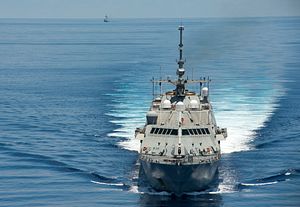For the third time since October, the U.S. military sent a guided missile destroyer within 12 nautical miles of a Chinese-occupied maritime feature in the South China Sea this month. These voyages, labeled “freedom of navigation” (FON) operations by the U.S. government, have drawn predictable scorn from Chinese officials and more subtle criticism from U.S. observers, many of whom push for more frequent, more assertive, or better-communicated operations. Several more fundamental questions about the program, however, generally go unaddressed.
For U.S. officials and a majority of reporters and commentators, the U.S. operations are part of a virtuous Freedom of Navigation Program designed to stand up for international law and prevent expansive claims in the waters of the world from gaining legitimacy through acquiescence. The U.S. debate revolves around whether the specific operations make the right legal points strongly enough or, through their behavior, actually lend legitimacy to Chinese claims of sovereignty or maritime rights not clearly supported by the UN Convention on the Law of the Sea.
For Chinese officials in the Ministry of Foreign Affairs and the Ministry of National Defense, the U.S. operations are “illegal” in unspecified ways, threatening to Chinese security and sovereignty interests, and part of an effort to use the rhetoric of “freedom of navigation” to stir up trouble and militarize the South China Sea dispute. They emphasize the risk of accident or miscalculation when U.S. and Chinese forces operate in proximity, and make the case that the Chinese military is acting responsibly while the U.S. ships unnecessarily raise tensions.
The basic difference is clear: U.S. rhetoric emphasizes subtleties of international law, and Chinese rhetoric portrays a thinly veiled show of force. You don’t have to endorse one government or the other’s position to agree that both versions of the story are incomplete. For instance, the U.S. government claims to champion UNCLOS but is not subject to the convention’s dispute resolution mechanisms because of its failure to ratify; and Chinese official complaints about militarization gloss over China’s own use of coercion against rival claimants.
The central question for U.S. policymakers who consider whether, when, and how to conduct FON operations in the South China Sea is what choices best reinforce U.S. objectives, and it is by no means clear that the recent U.S. approach has been doing so. While the U.S. debate has focused on legal subtleties and speculation about the meaning of “innocent passage” norms, several larger questions deserve far greater public discussion:
- Are military FON operations necessary to support the U.S. position about international maritime law? It is far from clear that conducting transits by warships is the only way for the U.S. government to make its position known and explicitly show that it does not acquiesce to other governments’ practices.
- Aside from demonstrating a legal position, what messages do U.S. FON operations send? Regardless of the stated U.S. intent of these maneuvers to peacefully demonstrate a legal position, observers will naturally note that the presence of a guided missile destroyer also coveys the potential for use of force. The debate over whether China’s government has “militarized” the South China Sea takes on a strained character when the U.S. government makes its own points using its military. To the extent that publicizing military presence and demonstration of resolve are elements of the desired message, these should be debated on their merits rather than as an adjunct to legal details.
- Is the mix of legal and other effects stemming from FON operations working out as advertised? This is an important question and not easy to answer. Supporters of regular FON operations in the South China Sea have emphasized that regularity itself will reduce the alarm with which the first operations were met. After three instances, however, there is no sign the Chinese government is acquiescing to the assertion that these voyages are routine. In each case, the diplomatic and security response has been robust, and the reportedly “unsafe” Chinese fighter intercept of a U.S. surveillance flight following the most recent FON operation may be a sign that the Chinese government is willing to engage in dangerous brinksmanship over the U.S. demonstrations that, in themselves, are not immediately dangerous. It is now difficult for either government to back down from its expressions of disagreement using military hardware, and FON operations are now part of that mix. It is possible further operations will result in routinization alongside the peaceful persistence of disagreement, but it is unclear why one would expect China’s government to stop expressing displeasure in ways that make U.S. officials nervous.
The most basic question, however, is one that has taken a back seat to the operational details of the three voyages to date: What does the U.S. government wish to accomplish with its South China Sea policy? The FON operations of the past seven months began in the context of a much broader debate over Asia-Pacific security priorities for the U.S. government, in which diverse voices called for U.S. policies that “impose costs” or, less specifically, “do something” about China’s activities in the South China Sea.
As the FON operations took the mantle of doing something, debate turned to whether that something was enough, and attention to the broader strategic questions seemed to wane. To understand whether the policy mix including FON operations is working, we need to reinstate the debate over what the U.S. government should be working toward.
Graham Webster (@gwbstr) is a senior fellow, U.S.–China relations, of the Paul Tsai China Center and a lecturer at Yale Law School. Sign up for his free e-mail brief, U.S.–China Week.

































